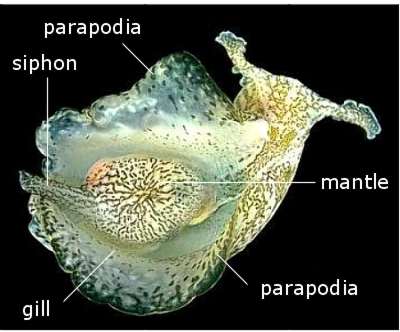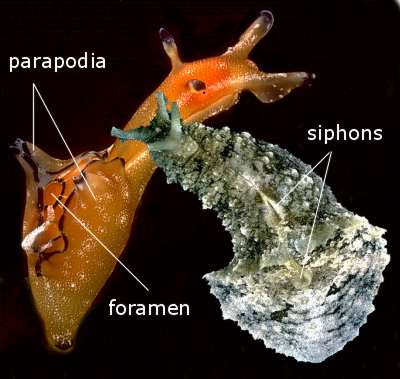

Aplysioidea - mantle cavity
Order: ANASPIDEA
Superfamily: APLYSIOIDEA
PHOTO
Upper: Syphonota geographica. Lower left: Aplysia parvula. Lower right: Dolabella auricularia. Photos: Bill Rudman
The Sea Hares, like all opisthobranch sea slugs show a tendency to lose the external 'snail' shell. In some genera it is completely lost, but in others the shell is reduced to a thin lightly calcified plate which is enclosed in a layer of the mantle tissue [see Sea Hare shell page].
To protect the gill and other organs previously hidden in the shell, sea hares have evolved large flaps of skin from the edge of their foot which we call parapodia. These fold up over the mantle and shell. In some sea hares, such as Dolabella, the parapodia fuse together to form a secondary parapodial chamber [lower right photo]. The only way into and out of this chamber is through a pair of siphons which allow fresh sea water to be pumped in over the gills, and deoxygenated water and waste products to be pumped out. The photo here of Syphonota geographica shows the parapodia folded out exposing the mantle which encloses the flattened shell. The mantle and shell form a thin ledge which covers the gill, the reproductive and kidney openings, and the anus. The space under the shell is all that remains of the mollusc mantle cavity. In Syphonota the posterior edge of the mantle forms a long exhalent siphon to ensure that waste products are expelled.
In most sea hares the shell cannot be seen although there is a microscopic hole in the centre of the mantle through into the shell cavity. In Aplysia parvula however, the hole [foramen] is very large. In the lower left photo it is edged with dark brown and the brownish shell can be clearly seen.
Authorship detailsRudman, W.B., 2004 (December 22) Aplysioidea - mantle cavity. [In] Sea Slug Forum. Australian Museum, Sydney. Available from http://www.seaslugforum.net/factsheet/aplymant
